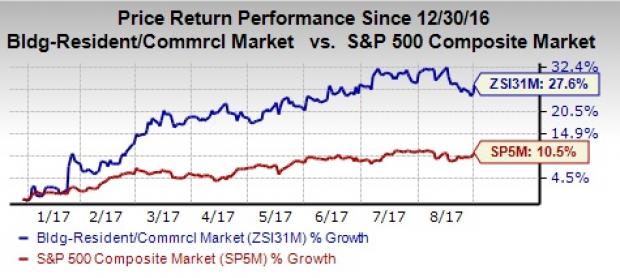Pending home sales took a turn for the worse in July as it fell for the fourth time in five months. This was primarily because the U.S. housing market witnessed limited options for sale due to intense competition.
Weakening Housing Data
Pending home sales, an indicator of the U.S. housing market, slipped 0.8% in July from the previous month, per the latest data released by the National Association of Relators or NAR. With this, pending home sales is now 1.3% down from the year-ago level and has declined on an annual basis in three of the past four months.
Pending home sales plunged in all the major regions, barring the west, on a month-over-month basis. Market analysts are of the opinion that the July decline mostly highlights the ongoing impact of limited supply on the U.S. housing market.
Lawrence Yun, chief economist at NAR, said, “The housing market remains stuck in a holding pattern with little signs of breaking through. The pace of new listings is not catching up with what’s being sold at an astonishingly fast pace.”
Meanwhile, existing home sales, which make up a larger part of all the U.S. real estate activity, slipped 1.3% last month to a seasonally adjusted annual rate of 5.4 million, according to the latest report published by the NAR. Although the July figure is still 2.1% higher year over year, the metric still represents a low point for 2017 so far.
This disappointing existing home sales data reflects the continuing inventory shortage prevailing in the U.S. real estate market.
The NAR group also slashed its expectation for existing home sales this year to 5.49 million from last month’s estimate of 5.56 million. Apart from limited supply, the NAR anticipates that the outlook for sales is less promising because purchases in the Houston area is likely to take a toll in the aftermath of Hurricane Harvey.
Softness in the Housing Market Ahead?
Investors should note that housing starts, permits and completions dropped 4.8%, 4.1% and 6.2% last month, respectively. New U.S. single-family home sales also unexpectedly fell 9.4% in July, the lowest level since December 2016.
The latest pending and existing home sales data has further added to the weak reports that were released recently in the U.S. housing market for July. This could more likely signal toward a soft housing market ahead. This is quite disappointing after the homebuilding industry saw the fastest quarterly home sales in a decade earlier this year and lent some much-needed support to the economy.
Further, with rising U.S. home prices, amid a tight supply situation and slow pace of construction, affordability has become a key issue right. The median existing-home price in July grew 6.2% from July 2016. July’s price increase marks the 65th straight month of year-over-year gains. Additionally, the median price of a new home increased 6.3% in July from a year ago to $313,700.
Homebuilding Losing Ground?
Land supply has been an ongoing challenge for the housing industry for a while now. Meanwhile, rising land and labor costs are threatening margins as they limit homebuilders’ pricing power.
The housing industry is cyclical and is affected by consumer confidence levels, prevailing economic conditions and interest rates. Although rising interest and mortgage rates, land and labor shortages, and rising material prices raise concerns, the 2017 outlook for homebuilding seems to be solid given strong economic growth and labor market.
The U.S. economy grew faster-than-anticipated in the second quarter (fastest pace in more than two years) and shows a significant jump from the first quarter’s lackluster 1.2% growth. The economy grew at an annual rate of 3% in the April-June period, the Commerce Department said in its second estimate on Aug 30.
Along with this, solid homebuilders’ confidence raises optimism for the entire construction sector. After dipping last month to 64 due to rising material costs, the index increased once again in August to 68 points, according to the National Association of Home Builders and Wells Fargo (NYSE:WFC) Housing Market Index report.
A few top-ranked stocks worth considering in the housing/homebuilding space are NVR, Inc. (NYSE:NVR) , Beazer Homes USA, Inc. (NYSE:BZH) , KB Home (NYSE:KBH) , M/I Homes, Inc. (NYSE:MHO) , Meritage Homes Corporation (NYSE:MTH) and Persimmon (LON:PSN) plc (OTC:PSMMY) . While NVR sports a Zacks Rank #1 (Strong Buy), the other stocks carry a Zacks Rank #2 (Buy). You can see the complete list of today’s Zacks #1 Rank stocks here.
Also, the homebuilding industry has returned a lot higher than the S&P 500 Index year to date. The industry grew more than 27% in the said period compared with the S&P 500 Index’s gain of 10.5%. Again, the Zacks Industry Rank for homebuilding is currently at #35 (top 14%) that raises much optimism.
More Stock News: This Is Bigger than the iPhone!
It could become the mother of all technological revolutions. Apple (NASDAQ:AAPL) sold a mere 1 billion iPhones in 10 years but a new breakthrough is expected to generate more than 27 billion devices in just 3 years, creating a $1.7 trillion market.
Zacks has just released a Special Report that spotlights this fast-emerging phenomenon and 6 tickers for taking advantage of it. If you don't buy now, you may kick yourself in 2020.
Click here for the 6 trades >>
KB Home (KBH): Free Stock Analysis Report
Beazer Homes USA, Inc. (BZH): Free Stock Analysis Report
NVR, Inc. (NVR): Free Stock Analysis Report
Meritage Corporation (MTH): Free Stock Analysis Report
M/I Homes, Inc. (MHO): Free Stock Analysis Report
Persimmon Plc (PSMMY): Free Stock Analysis Report
Original post
Zacks Investment Research
